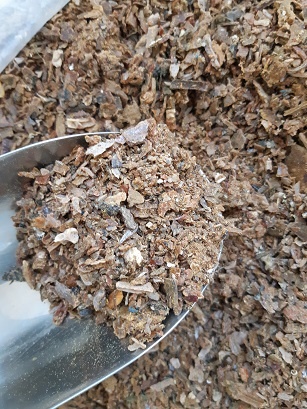How to determine the quality of propolis
According to the Polish Standard PN-R-78891, the classification of raw propolis to quality class I or II is based on the content of ethanol insoluble matter. In other words, it depends on the amount of wax and impurities.
The desired components of propolis, which means mainly resins, dissolve in ethanol (spirit), while wax and various solid impurities – such as wood splinters, pollen or chitinous fragments of bees – do not dissolve.

According to the Polish Standard, the 1st class includes propolis which contains not more than 30% of ethanol insoluble matter. It’s very little. It must be remembered that the bee, when depositing propolis in the hive, mixes the resins brought from the environment with the wax it produces. Thus, even a clod of seemingly pure propolis contains at least 25% of wax. For this reason, 1st class propolis, according to the Polish Standard, is extremely rare in wholesale trade.
The 2nd class includes propolis with the content of insoluble substances between 30% and 50%. Such goods are usually delivered by beekeepers to purchase centers.
How to determine the quality of your propolis? Unfortunately, judging by appearance can be deceptive. The only effective method is to dissolve a sample of propolis in spirit and weigh the undissolved residue. Such a method is described in the Polish Standard. It is quite simple and can be successfully made with minor modifications at home.

We will need:
– balance with an accuracy of at least 0.01 g. It can be, for example, a pocket jewelry scale available in many variants on the market at a price of about 25$
– white tissue paper (from the stationery store)
– funnel
– pencil
– approx. 40 ml of 95% alcohol (ethanol)
– two vessels with a capacity of 50-100 ml (one must have a tight closure)
– fridge
Execution:
1) Pour 20 ml of alcohol into the first vessel (the amount doesn’t have to be very precise).
2) Take 2.00 g from the propolis you want to evaluate (accuracy is important here) and place it in the first pot with alcohol. The sample should be crushed.
3) Close it tightly and leave it at room temperature in order for the propolis to dissolve. Mix it up from time to time. The amount of time depends on the intensity of mixing. According to the Polish Standard it will be 24 hours, but on an automatic agitator that mixes continuously. In home conditions, the time of 48 hours will work well, with repeated mixing by hand.
4) After that time, put it in the fridge for an hour.
5) Cut from the tissue paper a square of funnel dimensions, but not larger than 15×15 cm, weigh it and write down its weight. You can just write it on the tissue paper, but only with a pencil.
6) Fold the tissue paper in four and put it in the funnel, which in turn should be put it in the second vessel. Filter the contents of the first vessel. It will take a while.
7) When all the liquid is in the second vessel and only the insoluble residue is left on the tissue paper, remove the tissue paper with its contents (we can wait until it dries a little).
8) Twist the tissue paper so that the contents do not fall out and rinse in a small amount of fresh spirit (the first vessel can be used for this).
9) Leave the tissue paper to dry, and when it is completely dry, weigh it. Accuracy is important here.
10) Use the following formula to see the result:
y = (x-z) / w
where:
y: impurity content
x: weight of tissue paper with undissolved residue
z: weight of tissue paper itself
w: starting mass of the propolis sample (here 2g)
This way you will get a fractional result. Multiply this result times 100 to get the percentage.

